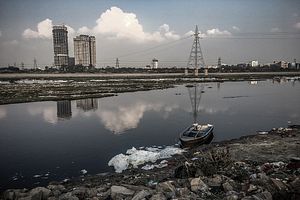Before you can see the Yamuna River or hear its roar, you smell its nauseating stench from a distance. When you finally glimpse it, the waterway looks like a sewer. Originating from the pristine Himalayan ranges further up north, the water of the Yamuna River carries with it raw sewage, untreated industrial runoff, and garbage as it flows through Delhi, destroying not only its marine life and biodiversity, but also the prospects for survival of those who depend on it for livelihood.
More than three-quarters of the pollution of the Yamuna, considered one of the most scared Indian rivers in Hindu lore, is found in a small stretch in Delhi – about 14 miles – that covers roughly 2 percent of the river’s total length, according to a monitoring committee overseeing its cleaning.
The Okhla area in South Delhi was the city’s prime fishing ground from the late 19th century to the early 20th century, according to the Delhi Gazetteers, but there’s no freshwater anymore. Instead, there’s a flow of untreated sewage, thanks to the discharge of toxic industrial chemicals released into the river.
The pollution has killed most of the fish population, but desperate fishermen, mostly migrants from the states of Bihar, Uttar Pradesh, and West Bengal, still cast their nets for whatever little they can catch.
The river is a testimony to the need for a balance between modern development that comes from industry and the conservation of natural assets. While the Indian government claims that it is spending millions of rupees on the cleaning of the Yamuna, the visible evidence gives a completely different picture, as shown in these photos.













































